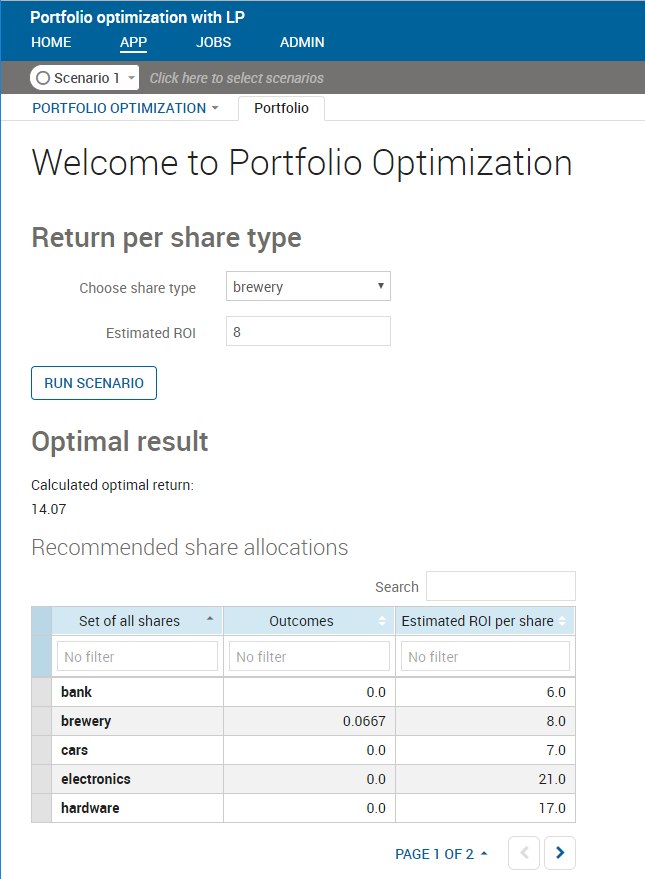Improving the User Interface
Doing this requires a slight change to the model, and this illustrates the iterative nature of Xpress Insight solution development. Start with a basic model, create an interface and iterate both as you seek to improve the user experience.
public declarations ... RET: array(SHARES) of real !@insight.manage input changeShare: string end-declarationsFor this example, a simple way to initialize it is by modifying the datainput procedure so that it now defines an initial value for the new scalar:
! Load input data
procedure datainput
initializations from DATAFILE
RET RISK NA
end-initializations
changeShare:= "brewery"
end-procedure Replace the
<vdl-form> containing the repeating fields, with a new form containing just two fields, so that the full
foliodata.vdl file now reads:
<vdl version="4.7">
<vdl-page>
<vdl-section heading="Welcome to Portfolio Optimization" heading-level="1">
<vdl-row>
<vdl-column heading="Return per share type" heading-level="2" size="4">
<vdl-form>
<vdl-field entity="changeShare" options-set="SHARES" label="Choose share type"></vdl-field>
<vdl-field entity="RET" indices="=scenario.entities.changeShare.value" label="Estimated ROI"></vdl-field>
</vdl-form>
<vdl-execute-button caption="Run scenario"></vdl-execute-button>
</vdl-column>
</vdl-row>
<vdl-row>
<vdl-column heading="Optimal result" heading-level="2">
<span vdl-text="Calculated optimal return: "></span>
<span vdl-text="=insight.Formatter.formatNumber(scenario.entities.Return.value, '00.##')"></span>
</vdl-column>
</vdl-row>
<vdl-row>
<vdl-column heading-level="3" heading="Recommended share allocations">
<vdl-table page-mode="paged" page-size="5" show-filter="true" column-filter="true">
<vdl-table-column entity="frac"></vdl-table-column>
<vdl-table-column entity="RET"></vdl-table-column>
</vdl-table>
</vdl-column>
</vdl-row>
</vdl-section>
</vdl-page>
</vdl> The first new
<vdl-field> element has its
entity attribute set to
changeShare - the new entity in the model. By using the
options-set attribute,
Xpress Insight is informed that the field should be a drop-down list, taking its set of options from the
SHARES set. The field is completed with the assignment of a label.
The second new <vdl-field> element references the RET array, with its indices attribute set to the value stored in the changeShare entity. Again, a suitable label is provided.

Improving the User Interface
The result is a much more compact user interface that conforms better to expectations.
Should you need them, radio buttons and check boxes are available as alternative VDL field types.
© 2001-2020 Fair Isaac Corporation. All rights reserved. This documentation is the property of Fair Isaac Corporation (“FICO”). Receipt or possession of this documentation does not convey rights to disclose, reproduce, make derivative works, use, or allow others to use it except solely for internal evaluation purposes to determine whether to purchase a license to the software described in this documentation, or as otherwise set forth in a written software license agreement between you and FICO (or a FICO affiliate). Use of this documentation and the software described in it must conform strictly to the foregoing permitted uses, and no other use is permitted.

